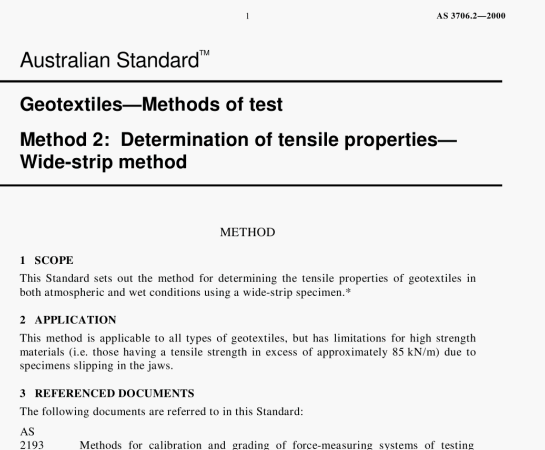AS 3706.2:2000 pdf – Geotextiles- Methods of test Method 2: Determination of tensile properties- Wide-strip method.
(b) Clamp the specimen centrally in the jaws with approximately equal lengths extending beyond the jaws at each end. Take care that the specimen length is parallel to the direction of application of force. Record whether it is a machine direction or cross-machine direction specimen.
(c) Start the testing machine and the area-measuring device, if used, and continue running the machine 10 specimen rupture (i.e. break). For machines with no autographic recorder, record the applied force and corresponding extension or elongation at a number of points up to specimen failure.
(d) If the specimen slips in the jaws. reject the result. Test another specimen from the same roll, after adoption of one of the following procedures:
(i) Padding the face of the jaws, e.g. with felt, cloth, or excess sample fabric.
(ii) Coating the specimen under the jaw face area.
(iii) Modifying the faces of the jaws.
(iv) Setting up two suitable steel rods of minimum length 210 mm. together with new specimens having their longer dimension in excess of 260 mm. in the tensile testing machine as shown in Figure 2.
(v) Using other jaw types such as wedge-shaped jaws. roller-locked jaws. and jaw faces, with a matched undulating/groove-type profile (see ASTM D 4595-86 and BS 6906, Part I). Care should be used with these jaws to ensure correct specimen alignment and gauge length. minimal specimen pre-tcnsion. and accurate measurement of specimen elongation.
(e) Repeat Steps (h) and (c) until 10 specimens have been tested.
NOTE: Further testing may be required in accordance with Steps (dl and ci). and Clause 10.3.
(f) Reject results if any of the following occurs, and for each rejected specimen test another specimen from the same roll:
(i) If three or more of the specimens break within 5 mm of the edge of the jaws.
(ii) If a specimen breaks within 5 mm of the edge of the jaws and results in a strength value below 20 percent of the average of all the other breaks. No other clamp-breaks are to be discarded unless the test is known to be faulty.
(iii) An abnormal result occurs in accordance with AS 3706.1.
For Item (i),when testing another specimen, adopt one of the procedures detailed in Step (d).
NOTES:
The decision to reject a test result is based on observation of the specimen during the test and upon the inherent variability of the fabric.
2 It is difticuli to determine precisely why certain specimens break near the edge of the jaws. If a jaw break is caused by damage to the specimen from the jaws, then the results should be discarded. If, however, it is merely due to randomly distributed weak places, it is a legitimate result. In sonic cases, it may also be caused by a concentration of stress in the area adjacent to the jaws because these prevent the specimen from contracting in width as the load is applied. In these cases, a break near the edge of the jaws is inevitable and acceptable as a characteristic of the particular test conditions.
AS 3706.2:2000 pdf – Geotextiles- Methods of test Method 2: Determination of tensile properties- Wide-strip method
